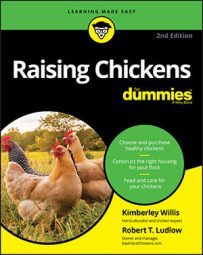Signs of external parasites include:
-
Seeing them crawling on the chickens or in the coop
-
Being bitten by them yourself
-
Noticing chickens with broken, chewed-looking feathers and reddened skin patches
-
Seeing chickens doing a lot of scratching and picking at themselves
-
A drop in egg production
-
Anemia with pale combs and wattles
-
A fluffed-up or sick appearance
Many people today are still willing to let nature call the shots, and they don’t worry about treating their chickens for parasites. If your chickens are acting healthy and producing as you want them to, you may decide not to treat them for parasites.
For those with small flocks that are handled frequently and that are confined at least part of the time, parasites may be unacceptable. Most external parasites that affect birds don’t live on humans, but a few will take a bite out of you if they get on you. You don’t want parasites on you, and you may want your chickens to be as comfortable and healthy as possible. You also may want optimum production. These are good reasons to choose to treat your birds for parasites.
Chicken lice
Lice are long, narrow, tiny insects that move quickly when you part a chicken’s feathers. The eggs are small dots glued to feathers. When your chicken has a heavy infestation, you can see the lice scurrying around on the bird. Unlike human lice, chicken lice don’t feed on blood; they eat feathers or shedding skin cells. There are head lice, body lice, and lice that live on feather shafts.To control lice you have to treat the birds directly — treating the environment doesn’t work. Permethrin, natural pyrethrum, and carbaryl dust are effective insecticides for lice, but you must consult a vet for the correct way to use them on chickens.
Chicken mites
Mites are very tiny rounded insects that can be seen only through a microscope and that will also bite humans. The most common mites in backyard coops are Northern Fowl mite, Common Chicken mite, Scaly Leg mite. Some types of mites feed at night on the birds and then hide in cracks of the environment during the day; others stay on the birds. They can cause anemia, decreased egg-laying, and damage to skin and feathers. Some types even invade the lungs and other organs. Heavy mite populations can cause death.Both the birds and the premises need to be treated for mites. Permethrin and several other good treatments exist.
A good treatment for Scaly Leg mites is petroleum jelly, linseed oil, or mineral oil applied liberally to the legs; these products smother the mites. Ask a poultry expert or vet for other treatment recommendations, because many good treatments aren’t registered for use with chickens.
Fowl tick and chickens
Ticks cause anemia, weight loss, decreased egg production, and general weakness in chickens. In the South, where this type of tick is most common, it can cause serious illness and even death in chickens. If you suspect ticks, go out and get a chicken several hours after dark and examine the skin closely in a good light. When filled with blood after their nightly meal, they’re large enough to see easily.Ticks are difficult to control. You don’t treat the chicken; you treat its surroundings. This means spraying housing and treating pasture areas and trimming or removing weeds and debris around poultry housing. Ask a vet for recommendations on tick control products.
Chickens and chiggers
Chiggers are nasty little bugs that don’t mind feeding on humans as well as chickens. Chickens get chiggers when they roam grassy areas or come into contact with hay or straw that’s infested with them. Chiggers cause great distress to chickens. They may appear ill and have no interest in eating or drinking. Their feathers appear fluffed up, and they scratch their skin a lot. Young birds sometimes die from heavy infestations.The control of chiggers is the same as with ticks: You treat the environment. In addition, any hay or straw stored close to chickens may need to be moved or destroyed.
Don’t try to eliminate parasites by spraying your housing with old-time remedies like kerosene or fuel oil. These products are environmental pollutants that cause more harm than good, and using them this way is illegal. They also can have toxic effects on your birds because they can be absorbed into your bird’s skin.

